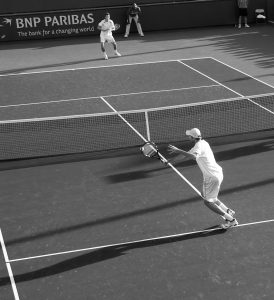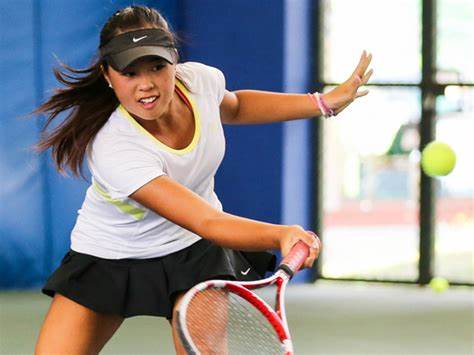What Is A Volley In Tennis?
A volley is a shot hit before the ball hits the ground, generally near the net. There are four different kinds of volleys: forehand volleys, backhand volleys, half volleys, and swinging volleys. The use of each one is dependent on your court position, the ball speed and direction, and your desired result and ability. How, when, and where to hit a volley will change depending on these factors.

How To Hit A Volley
To hit a volley, hold the racket with a continental grip. Begin movement by turning your body about 45 degrees toward the direction of the ball. Use the foot opposite of the ball side to step forward and toward the ball. To hit the ball, you will bring your racket head back slightly, then punch the ball toward your target. You will need a stiff wrist to hit a volley.
Volleys aren’t necessarily always meant to be a punch, however. For a fair amount of them (this really depends on your style and your opponents shots. Hard shots are sometimes met better with catching. Soft shots can be punched more), you will have more ‘catch’ on the ball instead of ‘punch’ on the ball. This is letting the ball come to your racket, and directing it’s placement with racket positioning. A slight punch, no punch, or slight backwards motion are all common. The constant between all volleys will be a strong, stiff wrist and stepping with your opposite foot.
Volleys are always hit before the ball bounces. Usually this occurs at the net because a lot of balls near the baseline that hasn’t hit the ground yet just might land out. This makes the physical motion of a volley different at the net than at the baseline. At the net, you will have shorter movements with feet, body, and arms. The further back you go, the more movement there will be in your volleys.
Forehand
When the ball is hit to your dominant side, turn with the opposite shoulder TOWARD the ball. At the same time, use that foot and point it slightly to your forehand side. As you turn, your racket will naturally draw backward. Hold a stiff wrist and move the racket head behind where the ball is going to be. As you step forward punch the ball toward your target. If the shot is powerful and you want to slow it down, catch the ball instead of punch. Hold your racket head in position or draw it back slightly as the ball hits the strings. Use the stability of the racket to control the direction.
Backhand
A backhand volley is hit on your non-dominant side. Bring your racket back with both hands while using the same motions as above, but opposite side. A backhand volley will more often be punched just to get enough power to be effective. As you bring your racket forward, you may have a short downward chopping motion in the punch. This makes a bit of a slice volley, very common for a backhand.
Swinging Volley
A swinging volley is when you take a groundstroke shot to a ball in the air. Usually the stroke does not have a full backswing or follow through. There isn’t usually time for those and using them would deplete control. If you are in no man’s land and on your way to the net, this shot may present itself. It is an awfully tempting shot, but should be practiced before attempting in a match. It’s wildly inconsistent at first and the ball is difficult to control. Once learned, it’s a wonderful weapon.
Half Volley
A half volley isn’t really a volley at all. It is hit just after the ball hits the ground, so it is hit on the rise, technically. It’s a shot usually hit at or just behind the service line. This shot is difficult to hit. A slight punch is usually required. Too much and the ball will sail out. Too little and you just gave your opponent a great approach shot. The ball could also end up in the bottom of the net.
Footwork and positioning are important for all the shots in tennis. A lot of players use a split step to prepare for a volley. As your opponent starts his shot, hop and land on the balls of your feet with them shoulder width apart. Keep your racket head in front of your face or neck area. If you hit a volley, which is by definition in the air, it is likely to be higher up than a groundstroke. Keeping your racket up keeps you prepared. Those shots can come at your face pretty quick if you aren’t ready.

When To Hit a Volley
Moving toward the net is an offensive strategy meant to diminish your opponents time and produce angles and opportunities no present from other court positions. Incorporate this strategy with any style of tennis. When an opponent hits a shot short in your court, use an approach shot to move forward and prepare yourself for a volley. Position yourself in the center of the court, slightly offset to the side your opponent is standing on. The idea is to close as many angles and shots your opponent can make for a winner. They will be forced to hit it back to you, which is what you want. This positioning is definitely not a rule, and will change for MANY reasons throughout a match. Focus on closing angles instead.
Volleys can be incorporated into your game right from the serve. The serve and volley style is when you hit a serve and immediately follow it to the net. You are now ready to hit a volley on your opponents return.
Where To Hit A Volley
Rarely do you want to hit a volley back to your opponent. Hit the ball to the open court to keep them moving. A ball hit while moving has a greater chance of being hit to the center of the court. This great opportunity to hit a put away is what you are after. Being able to hit the to the front and back of the court in addition to side to side will maximize the opportunities you have to control the point.
Practice Your Volleys
Hitting volleys should be in every lesson. Sometimes it won’t be the focus, but net play is crucial to success and should be incorporated in at least one drill every lesson. A good net player can end points quickly. Using angles and feel, positioning and placement, playing the net can give you an advantage over a majority of players who are focused on the baseline style.

